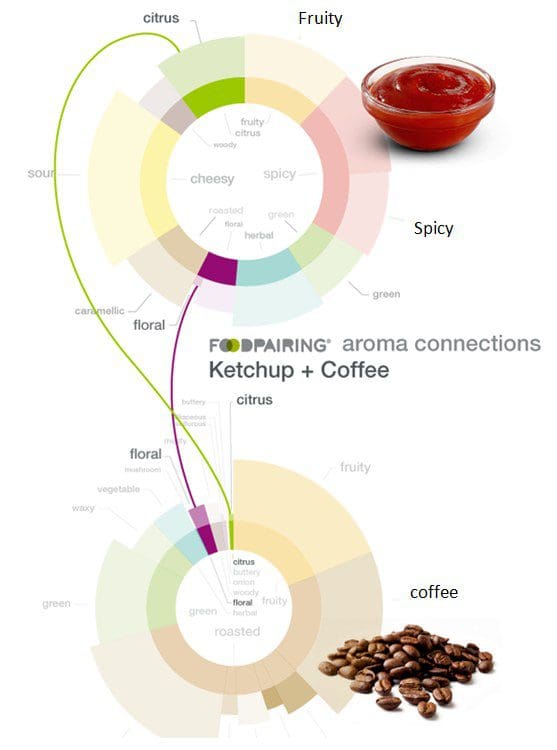A Tasty approach to data science
Data scientists at Foodpairing help brands cut down on the fuzzy front end of product development. The so-called Consumer Flavor Intelligence combines internet data and food science to create timely flavor line extensions.
By Natalia Hernandez, Foodpairing.
When brands are ready to create a new flavor, there is always an ideation phase where developers ask themselves “what can we create next?” At Foodpairing, we help brands answer that question through a hybrid method using consumer behavior data and scientific analysis.
Of course, when companies try to answer this question themselves, they begin spending too much time in the fuzzy front end (this is the time between idea conception of a new product flavor and the beginning of its development).
At this stage in flavor line development surveys are ineffective and expensive and trend reports are too general to provide a business with actionable insights. Companies are left to rely on intuition - a costly risk.
We named our approach to building new flavor lines Consumer Flavor Intelligence (CFI), which shortens the fuzzy front end of the product development process.
The Approach
Consumer behavior data is one of the elements at the core of CFI because of the massive insights it gives into what consumers are looking for in new flavors and tastes.
We developed this approach after we noticed that companies are facing 3 increasingly pervasive challenges to come up with new flavor lines.
First, consumers are no longer exclusively loyal to brands - the millennial flavor palate is evolving at a rapid pace and new products are constantly hitting the shelves in order to keep up.
Second, 76% of new product line extensions fail within a year - we attribute this to a lack of precision in the fuzzy front end of market.
Third, a new generation of agile companies have entered the markets. Local craft producers, for example, create strong brands with high quality, on-trend products. Their development cycle is shorter than multinational companies, creating a shorter time to market.
Together, this creates a generally risky environment for companies to try out new flavor lines. To address these numerous challenges, we created a solution that surveyed the market from a more holistic perspective.
Our data scientists mine public online data, which gives us general trend insights. We then complete an analysis using our molecular approach to food items. Here, we analyze aromas and measure their compatibility with other flavors. We also complete a brand analysis, which uses qualitative methods to describe the brand itself, including its visual identity and tone of voice, as well as the particular product’s attributes, such as texture and taste. We then can score flavor options against our analysis of the brand identity.
Fig. 1: How Foodpairing visualizes its approach to matching food ingredients. Their analysis identifies underlying aromas (fruity, vegetable, etc) and to what extent they’re dominant in the ingredient. They can then connect it to other ingredients with complementary ingredients.
Now is the time for data science and the food industry
The main benefit to a market research approach that embraces science, consumer data, chef inspiration is that it reduces the cost of trial and error for R&D teams.
The current toolbox in the fuzzy front end is not sufficient anymore. Marketing managers, development chefs, and R&D managers lack actionable market and consumer insights. Nowadays, research techniques work great in evaluation, but not during the idea generation phase.
When data is at the core of ideation, stakeholders from marketing to R&D can jointly take part in decision making, align on corporate goals and help increase the chances of a successful launch.
For us, it’s about ensuring that the right flavor comes onto the right market at the right moment. This is key to make a new flavor line successful. The market research we provide is tightly linked to consumer preference at that moment and into the future.
We continuously invest in having more unique data partnerships with key players in the market. This allows us to strengthen our prediction power.
Furthermore we really hope the general distrust in ‘big data’ of the FMCG/ food industry will decrease. We see how data and data driven strategies has changed industries like film, music, and automobiles.
We feel the time is now to embrace “data science” in the food & drink industry. We’ve set this ball in motion by becoming more active in market research organizations to increase the industry’s visibility. As an outsider in market research circles, we are excited at the prospective of challenging players in this sector to always be thinking of the next application of data.
Bio: Natalia Hernandez is a Data Scientist at Foodpairing. She has MS in Business Analytics and Big Data from the IE Business School in Madrid and BS in Industrial Engineering. Natalia’s first passion is food. Before completing engineering school she attended culinary school.
Related:

